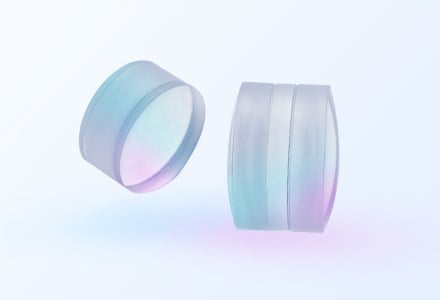
Ordinary achromatic lens refers to a lens group that corrects the color difference of light of three wavelengths (blue light, green light and red light).
Because the focus of the blue image of the light converged by the convergent lens is close, while the concave lens has a high divergence rate of the blue light, and the positive and negative color differences of the two mirrors are opposite, the red and blue images can coincide into one, and the color difference can be basically eliminated. The crescent surface can limit spherical aberration and coma aberration. But there are astigmatism and distortion. In the early stage, it was mostly used to shoot scenery, so it was called landscape lens.
The shape is crescent (concave convex), which is glued by two lenses with different refractive index and dispersion index. It was first made by kavilan in 1821 (flat concave bonded with biconvex lens); Later improved by grabi in 1857 (crescent). After that, multi-layer bonded achromatic lens appeared.
Chromatic aberration
Chromatic aberration is the difference of dispersion and refractive index of light with different wavelengths in glass, resulting in different focal points of light with different wavelengths. Using the collocation of different materials, such as the collocation of coronal plate and flint glass in convergent lens and divergent lens, the dispersion of each glass can be compensated by another glass, so as to minimize the comprehensive color difference.
Achromatic principle
Achromatic lens is composed of convex and concave lenses made of two glasses with different optical properties. Coronal glass with small refractive index and large dispersion ability is often used to make convex lens, and flint glass with large refractive index and small dispersion ability is used to make concave lens. Achromatic lens can only overlap the image points of the two main color lights (see Figure), so as to eliminate the color difference of the two color lights. For example, for visual aid optical instruments, considering the direct observation with eyes, the color difference between C line (red light with a wavelength of 656.3 nm) and f line (blue light with a wavelength of 486.1 nm) can be eliminated; For photographic lenses, from the perspective of photochemistry, the color difference between D-line (yellow light with a wavelength of 589.3 nm) and g-line (purple light with a wavelength of 430.8 nm) can be eliminated. Although there is still residual color difference for other color lights, it has little impact on general applications, and it can be considered that the color difference is basically eliminated.
Two piece achromatic lens
Two piece achromatic lens is one of the simplest achromatic lenses. It can be divided into two types: Double gluing and double separation. Of course, achromatic lens can also be composed of multi chip lens, which depends on its use needs. Achromatic lenses with large aperture are usually separated. They are assembled in the frame and have excellent comprehensive performance. For the double split lens, the gap between the two lenses is actually equivalent to the third lens, which can better eliminate the color difference than the glued lens. Therefore, it can balance the aberration in a wide range of wave bands and play a role in the field of broadband imaging.
Three piece achromatic lens
Compared with single lens or meniscus lens, three – Glued lens has the advantage of clearest and most realistic imaging In the projection system, neither single lens nor double lens can form the high-quality image that can be formed by three glued lenses If we compare the image definition with the naked eye, we can hardly find a lens with better performance than the three glued lens.
Development history of achromatic lens
C. M. hall first designed and made it in 1729, but he did not publish the invention at that time. In 1758, J. Dorland, a London optical instrument dealer, independently made achromatic lenses and used them in telescopes. In 1761, P. dolander, the son of J. dolander, successfully used achromatic lens in microscope.
Application of achromatic lens
Achromatic lens can not only eliminate chromatic aberration, but also eliminate spherical aberration by appropriately changing the radius of curvature of each surface. If the two kinds of glass constituting the double lens can be selected arbitrarily, it can eliminate coma at the same time.
There are also those that correct the color difference of three or four kinds of color light. At this time, the residual color difference is smaller. However, due to the difficulties in design and manufacturing, such achromatic lens is only used in some special occasions. Achromatic lenses are widely used. A multi lens optical system is often composed of multiple achromatic lenses. High quality microscopic objective lens and photographic lens are complex lens combination systems that eliminate both chromatic aberration and other monochromatic aberration.
Simple square box cameras and children’s cameras are mostly equipped with achromatic lenses.
End



